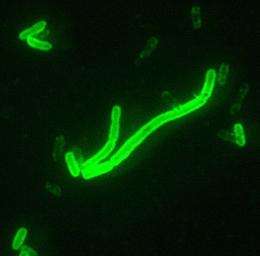February 12, 2014 report
Study of last plague outbreak in China sheds light on modes of transmission

(Medical Xpress)—A team of Norwegian and Chinese researchers has traced the spread of the last plague outbreak in China—in so doing they have found that the disease followed roads, rivers and coastlines to jump to new locations. There were also, the team notes in their paper published in the journal Proceedings of the Royal Society B, jumps associated with increased rainfall that led to flooding.
When scientists study the way a viral or bacterial epidemic grows, they usually focus on the way it spreads from an epicenter outwards to the local area. In this new effort, the researchers wanted to find examples in history of an outbreak that jumped to far flung areas, hopefully to learn more about how such jumps occur. The researchers chose the last outbreak of the plague (Black Death) in China, which occurred approximately between the years 1855 and 1959.
After digging up many documents and analyzing them, the team was able to learn that the disease started in a town called Yunnan—from there it expanded outward as would be expected, infecting people over a larger and larger area. But, the team also found that infections tended to spread faster along road, river or coastlines—people moving along such routes were carrying the disease with them, which allowed the disease to make major jumps in very short time periods. There was also another, somewhat surprising shift in transmission—times of wetness. Documents revealed that the disease tended to make odd jumps when it rained heavily in an area causing flooding. The researchers suggest this occurred because people, and rodents, fled to other drier places, some of them taking the disease with them.
Studying how epidemics in the past spread is helpful in predicting how they might spread in the future—given humans vastly greater reach in the modern era and faster modes of transportation. Combining data from long ago with more recent data can help to build models to help planners create plans for dealing with easily spread pathogens when they emerge, and hopefully, help ward off something truly cataclysmic.
Such studies as the one done in China are likely to become even more important as global warming continues, bringing with it not just warmer weather (which is more conducive to outbreaks) but flooding which could displace massive numbers of people in the coming years, many of whom could be carrying an infectious disease.
More information: Wet climate and transportation routes accelerate spread of human plague, Proc. R. Soc. B 7 April 2014 vol. 281 no. 1780 20133159, Published 12 February 2014 DOI: 10.1098/rspb.2013.3159
Abstract
Currently, large-scale transmissions of infectious diseases are becoming more closely associated with accelerated globalization and climate change, but quantitative analyses are still rare. By using an extensive dataset consisting of date and location of cases for the third plague pandemic from 1772 to 1964 in China and a novel method (nearest neighbour approach) which deals with both short- and long-distance transmissions, we found the presence of major roads, rivers and coastline accelerated the spread of plague and shaped the transmission patterns. We found that plague spread velocity was positively associated with wet conditions (measured by an index of drought and flood events) in China, probably due to flood-driven transmission by people or rodents. Our study provides new insights on transmission patterns and possible mechanisms behind variability in transmission speed, with implications for prevention and control measures. The methodology may also be applicable to studies of disease dynamics or species movement in other systems.
© 2014 Medical Xpress


















